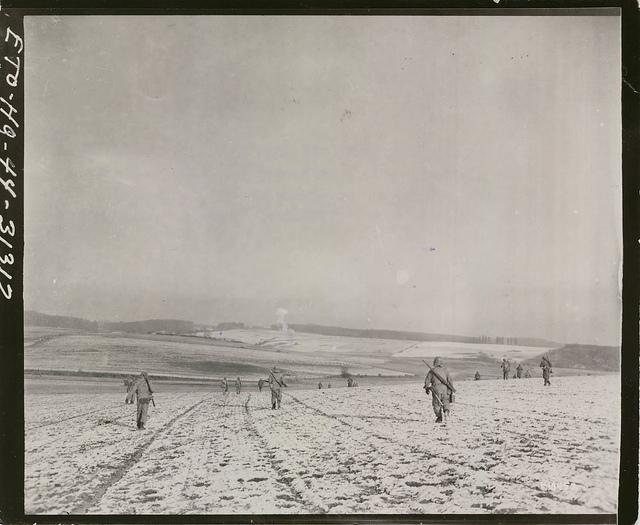SC 198452 - Infantrymen of the 10th Armored Infantry Battalion, 4th AD, heading to Bastogne, 27 December 1944.
The following is excerpts from Ray Moore’s "Terrify and Destroy" pamphlet (c. 1944).
“Stone of Bastogne” Blunts Nazi Blitz
Greying dusk shrouded Bastogne as CCB’s lead Sherman tanks, tank destroyers and half-tracks rolled through the town 18 December 1944. These were the first combat troops to reach the threatened city. CCB’s commander, Col. William L. Roberts, split his command to form a crescent-shaped arc facing eastward five miles from the city. A task force commanded by Maj. William R. Desobry went north to Noville, while a similar group under Lt. Col. Henry T. Cherry wheeled east to Longvilly. Lt. Col. James O'Hara’s group shifted southeast to Bras.
While the Tiger’s steal treaded tanks ground over Bastogne’s cobble-stoned streets, the avalanche of Germanmight rolled westward with increasing momentum. Capture Bastogne, hub from which seven main roads spread spoke-like in all directions, was essential to the swift movement of Rundstedt’s panzers. Riding the crest of a 14-mile advance, five Nazi divisions knifed through the fog and engaged CCB in the pre-dawn darkness of 19 December.
For the first time since he launched his assault, Von Rundstedt was stopped!
Bazooka-armed doughboys and a single platoon of tank destroyers came to grips with a column of German Panzer IV tanks on the Houffalize-Noville highway, turned them back after a furious engagement. More enemy armor followed and with the road blocked, the battle spilled into the snow-mantled fields and woods, raged unabated.
For eight hours, CCB alone withstood the multiple blows of the Nazi’s Hydra-headed attack. Then help arrived. First reinforcements of the 101st Airborne Div., which had moved into Bastogne under the screen of the 10th’s actions.
Drawing from a seemingly endless reservoir of might, Germans still maintained an overwhelming balance of power. The outnumbered Americans shifted their defensive arc nearer Bastogne.
Balked frontally, the German attack swirled around the city, shooting pincers to the north and south. The night of 21 December, the pincers met and closed west of the city. Bastogne became the “hole in the dough-nut.”
In the center of the hole, the 10th assembled a highly mobile reserve force to strike in any direction. Bastogne’s “Fire Brigade,” as it was called, fought wherever the battle flamed hottest. This force was Bastogne’s indispensable backbone of steel.
The remainder of the epic, like the beginning, is a tale of the individual soldier’s raw courage.
The Tigers saw the fanatical enemy press in from all sides; rocked beneath terrific artillery barrages and repeated bombing; froze in ice-filled foxholes and along the snow-covered slopes; watched supplies and ammunition dwindle. Threatened with extinction, they echoed Maj. Gen. Anthony McAuliffe’s reply of “Nuts” to the German surrender ultimatum. Men of the 10th stood, fought, died.
Fourth Armored Division tanks cracked the ring on 26 December, but CCB’s fight wasn’t over. The weary, triumphant Tigers did not take their final ride through Bastogne’s rubble strewn streets until 18 January.
In 30 days of hell, these men of CCB had earned the Presidential Unit Citation (United States), formerly the Distinguished Unit Badge.
Information

Warning: This is a relatively older thread
This discussion is older than 360 days. Some information contained in it may no longer be current.
- Knowledge Library

- MKL Entry of the Month
- Australia
- Austro-Hungarian Empire
- Canada
- Czechoslovakia
- Denmark
- Finland
- France/Belgium
- Germany
- Italy
- Japan
- Norway
- Russia
- South America
- Sweden
- Switzerland
- Turkey
- United Kingdom
- United States
- Yugoslavia
- Is my rifle authentic or a fake?
- Jay Currah's Lee Enfield Web Site
- On-line Service Records (Canada)
- Technical Articles/Research
- Forum
- Classifieds

- What's New?
-
Photo Gallery

- Photo Gallery Options
- Photo Gallery Home
- Search Photo Gallery List
-
Photo Gallery Search
- Video Club

- iTrader












 PM
PM
